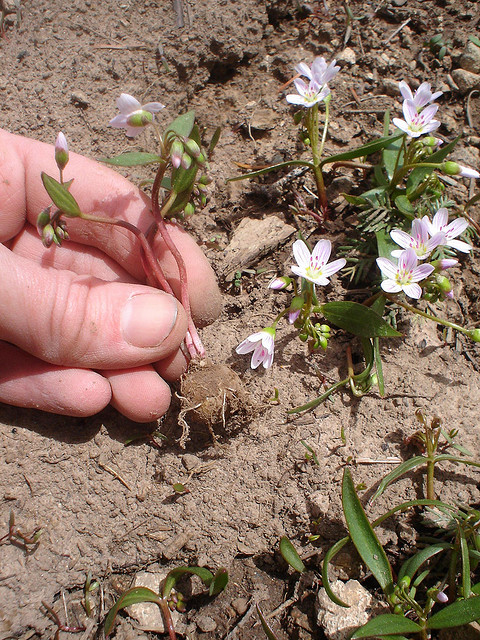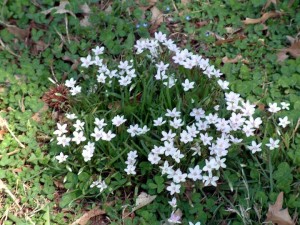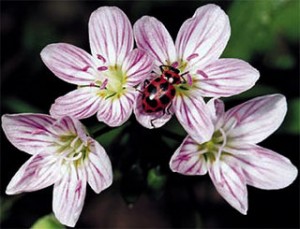
The entire Spring Beauty is edible, root to blossoms. Photo by BushcraftUSA.
The Spring Beauty is aptly named.
Actually there are several “Spring Beauties” and most of them are edible in similar ways. We’ll focus on Claytonia virginica, a member of the greater Purslane family. It’s found in the eastern two thirds of North America starting with Texas heading north and east, not counting Florida, New Hampshire, Maine and Canadian points east of Maine. Other “beauties” mentioned are found in different areas of North America.

Spring Beauties can be plentiful or rare. Photo by Illinois Flowers.
The Spring Beauty, also Springbeauty, is a longtime standard for foragers. They are abundant in some areas, rare in others. Thus forage with some local consideration. True to its name the attractive wild flower is a sign of spring and easy to recognize from other spring blossoms. The white to pink petals have pink stripes, sometimes pale, sometimes bright, but pink stripes nonetheless. Each blossom also only has two sepals (leaves right under the blossom.) Lower leaves are strap-like varying in size and width. The plant grows small roots that remind people of tiny potatoes, hence the nickname “Fairy Spuds.” At least one botanist said you can eat them “but their small size makes this rather impractical.” Famous forager Euell Gibbons clearly would disagree.
In his book “Stalking The Wild Asparagus” Gibbons wrote about eating them daily if not twice a day for several weeks. He said: “We tried them fried, mashed, in salads, and cooked with peas, like new potatoes. All these ways were completely successful, but, as regular fare, we preferred them just boiled ‘in the jackets.’ My friend grew so fond of this food that he was afraid he would experience withdrawal symptoms when the supply was exhausted.” While Gibbon’s friend thought they tasted like potatoes Gibbons thought they were sweeter, closer to chestnuts in flavor.
The small roots, or fleshy taproots, of several species were eaten by the natives as well as the leaves. Those species include Claytonia acutifolia (Alaska) Claytonia caroliniana (eastern North America) Claytonia lancelolata (western North America) Claytonia megarrhiza (Rocky Mountains) Claytonia tuberosa (Alaska) and the aforementioned Claytonia virginica.
The genus is named for John Clayton, 1694-1773, who was a Colonial plant collector and tobacco farmer in Virginia. He came to the “colonies in 1715 to join his father who was an attorney. He became clerk of the courts for Gloucester County, Virginia in 1720, married Elizabeth Whiting and soon after that began to collect plant specimens and have eight kids, not necessarily in that order; three daughters and five sons, some involved in the formation of the United States. Clayton sent many plant specimens but no kids to Europe where the specimens were studied by scholars. In Clayton’s honor, Linnaeus named the Spring Beauty after him.
Green Deane’s “Itemized” Plant Profile: Spring Beauty
IDENTIFICATION: Claytonia virginica: Perennial three to six inches high with flowers a raceme on the end of stems. Each blossom up to half an inch across, 5 pink-streaked white petals, 2 green sepals, 5 stamens with pink anthers. The flowers open when it’s warm and sunny, close when cloudy or at night. Pleasantly scented. The flower stems are weak, light green or reddish green, smooth. Basal leaves linear or linear-lanceolate, curving back, smooth along the edges, fleshy. Each three to six inch leaf has a single central vein, width varies. The leaves do not have stems. However, the leaves of the C. caroliniana which are ovate, do have a short stem. Roots resemble small potatoes more or less. If you see a lot of blossoms in something of a circle there may be a larger root in the middle. Roots are two to three inches underground.
ENVIRONMENT: Prefers dappled sunlight in spring, moist to slightly dry conditions, rich friable soil. It can adapt to semi-shaded lawns if not mowed in the spring.
TIME OF YEAR: This is a bit of an issue. They would be best harvested in the fall but they are hard to find then. And in the spring they use that stored energy to reproduce. You either have to know where they are or catch them in the early spring as soon as they can be identified. March to May.
METHOD OF PREPARATION: All the parts above ground raw or cooked, roots cooked. Roots can be eaten raw but not the most pleasant of experiences. You also don’t have to peel them but they are better peeled. Gibbon’s “peeled” them by putting them in a basket and putting them under a water fall. A garden hose might work but I’ve never collected enough of them to give it a time-saving try. Peeling can also be easily done after cooking. Because of their size Spring Beauties take a while to collect. They are a treat, not a staple.





Come up to Missouri Dean,Let’s go foraging. =)
I’d really like to find this “Spring Beauty”
These grow abundantly on some land my family owns in upper Maryland and they are delicious. Jeff, if you end up reading this, I really hope you get to find some. The tubers taste like mild chestnuts with the texture of a well cooked potato.
I do not know about the greens, but the roots can be microwaved with more success than potatoes. I can collect a double handfull in about an hour when abundant and blooming. I worry about missidentification any other time of the year. eat the peal.
hello, I’ve noticed Claytonia spieces growing here in the forests of the north west.
when you say most spring beauties are edible in different ways… are there any of which you know that have poisonous parts, or ones that should be avoided all together?
A species in particular i’ve seen growing here in the NW, is Claytonia cordifolia, would you happen to have any input or palatable experience regarding the edibility or inedibility of this particular species?
Might be Carolina geranium…
Hey. I have a question. Can you eat the leaves raw and are the flowers edible?
Yes we used to pick these in the hills of eastern ky and would cook the whole plant like greens. We called it tangle gut. Also would eat as we picked
Hi Rebekah, the caption under the first picture should answer your question. They grow abundantly in the Wasatch Range, Utah.
As far as I know it is NOT edible.
Spring beauties are not common and take 7-10 years to grow from seed to flower. Collecting the bulbs or removing the leaves is lethal, it kills the plant. Harvest should be very sparing, I would suggest harvesting no more than 1% of the plants you find. Studies have shown that slowly reproducing spring ephemerals like spring beauty, ramps, trout lily and toothwort can sustain their population numbers only if no more than 10% is harvested once every 10 years. Is it really worth endangering this plant for the tiny amount of food it provides?
Thanks for posting Judy, you are so right!
Like he said, it depends where you are and you need to be aware of local abundance. Where I grew up in Indiana and in certain parts of Ohio, they’re extremely common, they’re practically ground cover in places. Where I live now they’re almost non-existent, although they’ve started to pop up in my parents yard on the other side of town since they’ve let things go a bit on one of their hills.
They are everywhere here in west central Indiana…my woods is full of them.
Thank you! Your information allowed me to identify this. It is growing in my “yard”!
There are lots of these where I live. After reading your post, I’ve tried the tubers both raw and cooked. I also tried the stems, leaves and flowers. I found that the stems and/or leave left a very unpleasant aftertaste that would not go away for about an hour.